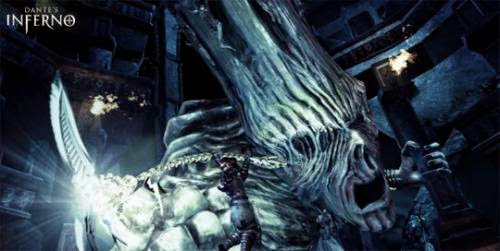
The similarities can't be denied. While January's DARKSIDERS was an exercise in Frankensteining together gameplay elements lifted from other franchises, including many from God of War, DANTE'S INFERNO is so similar to Kratos' games that it's nearly a re-skinning of Santa Monica Studio's work. It becomes difficult to say that Visceral is actually responsible for creating this game, because if I had no prior knowledge of the developer while playing, I would, without a second thought, assume it to have been made by the God of War team. I feel like David Jaffe, Cory Barlog, and company may deserve some royalty checks.
With these not-so-keen observations out of the way, it is not hard to praise DANTE'S INFERNO for refined and tangible combat that gives players a variety of differing ways to dispatch demon spawn and monstrous boss characters. Dante wields a scythe and a magical cross as his two primary weapons, these representing the diametrically opposed forces of Inferno and Paradiso, and also learns magic spells along the way that consume mana when cast during combat. What makes the combat effective is the way that Dante's techniques differ from one another and become more or less useful depending on the situation and opposition. The breadth of options also makes for far more interesting gameplay than something like BAYONETTA, where many of the basic, pawing combos feel identical to one another. Each strike in DANTE'S INFENO, like the God of War games, has a heavy "feel" to it, and the sense of contact is intensely satisfying. The way enemies are thrown at Dante, however, is not perfect, with curious combinations making battles lack the sense of dramatic pacing that can be found more broadly over the course of the game.
A light "good and evil" system is incorporated into the game, and determines which skills Dante will learn as players progress through Hell. From a raw gameplay perspective, this game's pick-and-choose approach works better than a more severe morality system where the two sides operate like scales on a balance. Here, regardless of decisions, the player earns rewards equally and concurrently on both the light and dark sides of the coin. Unlike some other systems, this means that radicalism needn't be practiced in order to build Dante into a more formidable warrior, and players can play how they wish and make decisions as they like. The problem with the system, though, is that the choices amount only to either absolving or punishing enemies and NPCs for their sins, and have very little bearing on the game's overall plot.
DANTE'S INFERNO does an excellent job of using finely-crafted representations of the circles of Hell as an invigorating and interesting interstitial fluid through which players will enjoy travelling between combat sequences. The attention to detail in these thoughtfully designed environments, which are viewed through a semi-static, yet always well oriented and dramatic camera, once again remind us why this development studio calls itself "Visceral." In the second circle, Lust, Dante battles naked demonettes who make sexually provocative gestures, touch themselves, and sprout tentacles from between their legs to capture him as he climbs a phallic tower to confront the area's boss characters. The third circle, Gluttony, is essentially a long digestive tract, featuring intestinal worms and fat, putrid enemies covered in mouths, including ones that replace their hands. These images will undoubtedly leave an impression on gamers, even though the actual narrative feels somewhat underdeveloped and doesn't reach its full potential.
The majority of the game's setting rivals the aforementioned examples in aesthetic quality, but its creative and immersive design takes an extreme nosedive as players near the end of the journey. The final circles of Inferno are characterized by repeated arena battles in a series of nearly identical rooms, each with specific requirements and limitations. It makes absolutely no sense why this would be so, especially at the end of the game. This design leads one to believe DANTE'S INFERNO wasn't ready when EA and Visceral needed it to be (possibly for a head-start on GOD OF WAR III, due next month), so the developers spit these sub-par bits out, slapped on an end-boss, and rushed the game out the door. It's quite unfortunate to have experienced this, after the care that went into the design of everything in the first seven or so of the nine circles.
Finishing DANTE'S INFERNO is like playing two games. The tight, polished, interesting, and enjoyable God of War clone switches suddenly into a boring, forgettable, hack-and-slash game with no inspiration or variety, and the change can certainly leave a bad taste in the player's mouth at the end. Still, the value of the earlier stages and the core gameplay mechanics shouldn't be ignored, because those aspects are excellent. Fans of the genre should absolutely experience DANTE'S INFERNO, but overall, the recently released DARKSIDERS delivers a better, more complete package, and the upcoming GOD OF WAR III sports a very promising pedigree that is also worth considering" = "UA-891678-1";
urchinTracker();
Credit: practicing-wicca.blogspot.com


















